
Rachel Whitlow
About the Author
Rachel Whitlow is a young yet promising coin dealer with expertise in American coinage, focusing on quarters with silver struck by the US Mint. Rachel began her journey early – by the age of 18, she had already completed professional coin grading courses delivered by the Professional Coin Grading Service (PCGS) and the American Numismatic Association (ANA).
To prove her competence, Rachel Whitlow gained her Master’s degree in Art History with a concentration in material culture, i.e., coins, currency, and historical artifacts in particular. Today, she is a proud founder of the growing coin appraisal service which is yet to break the monopoly on the American numismatic market. “Sleeper coins” are her blessing, and undervalued rarities that others often overlook cannot pass by the rising star. Coin intuition at its best!
Follow Rachel on Social Media



The Silver Age of the US Quarters
When quarters were silver, the world seemed a bit more promising.
The age of 25-cent silver coins was quite long. Before they turned into ordinary-crafted units of currency that generally hold their face value only, US quarters were made of real silver. Precious metals were meant to boost the public’s confidence in the value and stability of a nation’s currency.
The first silver 25-cent coins were minted in 1796 under the Draped Bust design. Indeed, they were limited in number, which only facilitated their rise on the numismatic market. With each new design (and through the gaps that were left in-between), the US Mint finally established a golden silver standard – 90% silver and 10% copper with a net silver content of 0.1808 troy oz per coin.
Nevertheless, the silver quarter years are gone, and they represent timeless artifacts or, rather, collectors’ assets, having largely disappeared from everyday circulation decades ago. So, when did they stop making silver quarters after all?
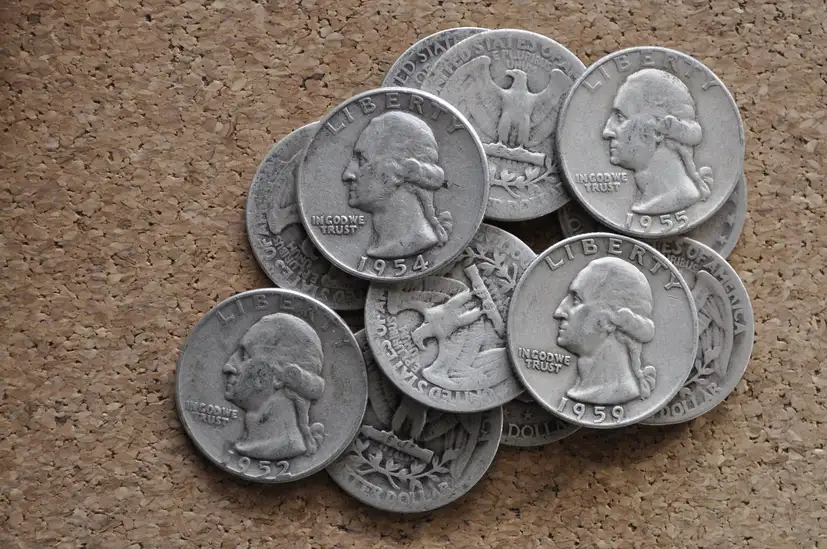
What Quarters Are Silver?
Not all coins are the same. The US quarter, however ubiquitous and universal it may seem at first, has undergone several modifications, leaving numerous designs strongly associated with silver behind. This mainly happened before 1965, though occasional issues minted after that year, bearing Ag in their composition, do exist.
So, what year quarters are silver? How much does a silver quarter weigh? And how much silver is in a quarter (in troy ounces)? Here are the iterations of the beloved numismatic creation that hides precious metals inside.
*Note: While average circulating quarters minted after 1964 are no longer silver, the US Mint officially releases proof and collector’s editions in silver within new series and exclusive issues on a regular basis (e.g., America the Beautiful, American Women, 1976 Bicentennial, etc.). These are never intended for general circulation but are prized by collectors anyway.
But what year did they stop making silver quarters?
The End of the Silver Era
When did quarters stop being silver? By the 1960s, the rising prices of Ag became a major problem that posed a threat to the coin production in the US. What happened then? The intrinsic silver quarter value began to approach or, in some cases, exceed its face value, leading to widespread hoarding all across the country.
So as to resolve an issue, Congress passed the Coinage Act of 1965, which forced the Mint to remove silver from quarters (as well as dimes, too) and introduce a new composition of copper-nickel clad. This is how 1964 put an end to the epoch of inherently valuable units and became the last year of silver quarters in the numismatic history of the US.
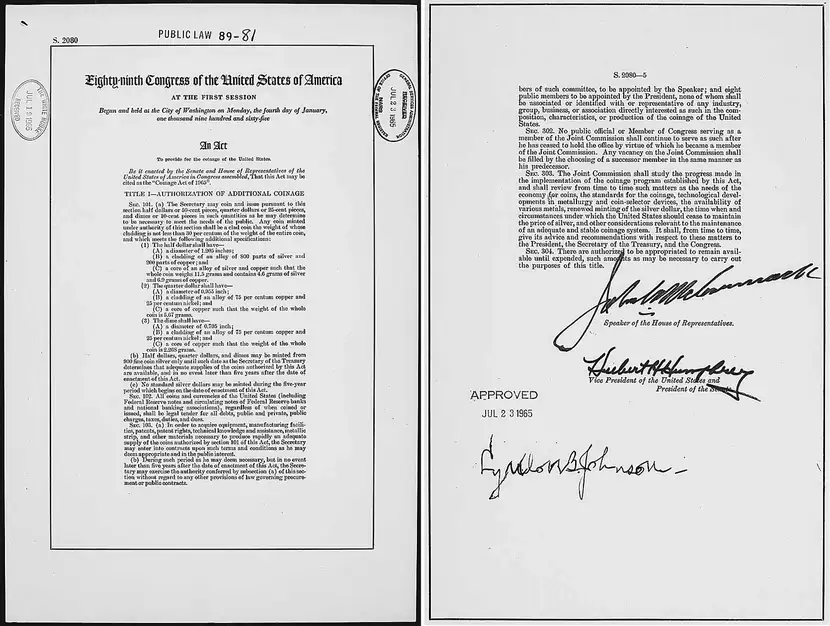
What Makes a 25C Coin Valuable?
How much is a silver quarter worth? “Worth” is a vague term that, notwithstanding the fact that it can be measured, cannot be fully defined without context, be it of historical, emotional, or market-driven nature. When referring to numismatic creations that we are to discuss in the material, the value of silver quarters typically exceeds the one reflected on its face or even the precious metal content, which is a long-way process, though. But why?
- Rarity: A coin’s mintage (how many were produced) and survival rate (how many still exist in collectible condition) are vital. The lower the mintage, the higher the price.
- Condition (Grade): Coins might be graded on a 70-point scale, with “Mint state” issues (MS-60 and above) being the most valuable. Flawless surfaces, sharp details, and original luster – this is what defines how much a coin may cost in the end.
- Mint Marks: The place of origin matters. Quarters from branch mints like Carson City (CC) and San Francisco (S) may be scarcer than their Philadelphia counterparts and, hence, more valuable.
- Errors: Misstrikes, double dies, off-center strikes, overdates, and other minting anomalies turn ordinary, uniform coins into exclusive creations with something that makes them one–of-a-kind.
Top 15 Most Valuable Silver Quarters
1796 Draped Bust 25C
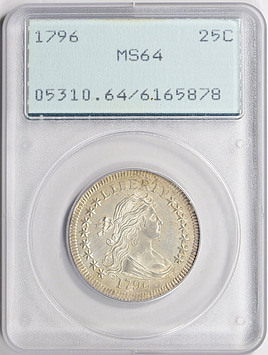
Auction Record: $1,740,000
Produced by: Philadelphia Mint
Mintage: 6,146
Metal Content: 89.2% Silver, 10.8% Copper
Weight: 6.74 g (0.2419 oz)
The 1796 Draped Bust 25C is one of the most iconic and valuable coins in U.S. history. It was the first year of the Draped Bust design (and the first year of silver coin production), which makes it an extremely rare early issue of all time. According to P. Scott Rubin, only twenty to forty-five instances were brought to auctions, though unique circumstances of production made collectors initially think that these coins should turn into a treasure over time.
1807 Draped Bust 25C
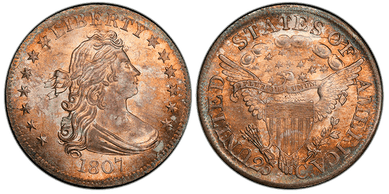
Auction Record: $630,000
Produced by: Philadelphia Mint
Mintage: 220,643
Metal Content: 89.2% Silver, 10.8% Copper
Weight: 6.74 g (0.2419 oz)
How much are silver quarters worth? An overwhelming sum! The 1807 Draped Bust 25C was the final year of the series, which can be called fruitful enough, thanks to the largest mintage and quality of striking. As for the latter, weak die strikes and worn production equipment made it almost impossible to spot fully struck specimens, making even moderately well-preserved examples highly collectible.
1820 Capped Bust 25C (Browning 3, Medium 0)
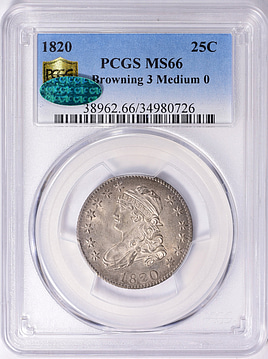
Auction Record: $80,650
Produced by: Philadelphia Mint
Mintage: Part of the total 127,444 for the year; specific variety mintage unknown
Metal Content: 89.2% Silver, 10.8% Copper
Weight: 6.74 g (0.2419 oz)
Coins that are two centuries old should always be considered unique to explore. The 1820 Capped Bust 25C is distinguished by its variety, which is divided into two major groups based on the size of the “0” in the date: the Large 0 and Small 0. However, Tompkins also recognizes a Medium 0 with a Browning 3 designation.
The controversy makes it a coveted asset. While PCGS does not recognize this variety as a separate one, other reputable services do. This is how they are able to charge premium prices, with limited availability also taken into consideration.
1827/3 Capped Bust 25C
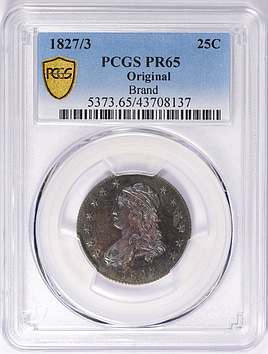
Auction Record: $444,000
Produced by: Philadelphia Mint
Mintage: 4,000
Metal Content: 89.2% Silver, 10.8% Copper
Weight: 6.74 g (0.2419 oz)
Here comes the classic rarity of American numismatics. The overdate deviation is one of the most appealing for collectors, as it features the “3” from the previous year, 1823, beneath the “7” of the 1827 date. As Denis Loring stated, there exist only nine examples of this issue, and eight of them are PF-60 or better. Quite surprising for a coin with a long history.
1865-S Seated Liberty 25C
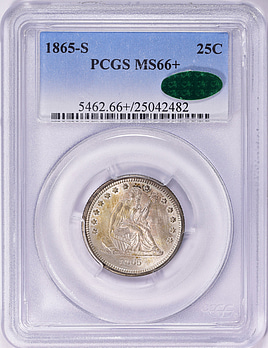
Auction Record: $80,600
Produced by: San Francisco Mint
Mintage: 41,000
Metal Content: 90% Silver, 10% Copper
Weight: 6.25 g (0.1808 oz)
In 1865, the San Francisco Mint, which is one of three main minting facilities in the US, saw a significant production jump, with the mintage of 25C coins more than doubling compared to the previous year. However, this still resulted in a very limited output, with only 41,000 coins struck. Low mintage and scarcity of well-preserved examples are quite flabbergasting, and owning one means a true fortune, since known samples are in private collections only.
1873-CC Seated Liberty 25C Arrows
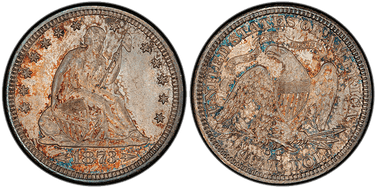
Auction Record: $336,000
Produced by: Carson City Mint
Mintage: 12,462
Metal Content: 90% Silver, 10% Copper
Weight: 6.25 g (0.1808 oz)
The 1873-CC Arrows 25C is one of the rarest and most desirable coins in the series. “Arrows” means a variety that obviously features arrows next to the date to indicate a change in the silver quarter weight. In fact, it was the first year when the US Mint produced quarters with a new weight standard as an experiment to lower the production price.
1901-S Barber 25C
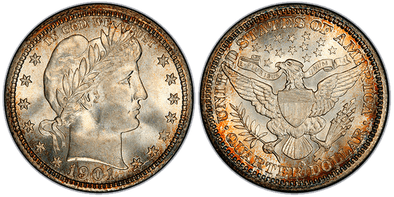
Auction Record: $550,000
Produced by: San Francisco Mint
Mintage: 72,664
Metal Content: 90% Silver, 10% Copper
Weight: 6.25 g (0.1808 oz)
Hands down to the legend! The 1901-S Barber quarters made of silver are honorably considered the rarest regular-issue quarter made of silver in the 20th century. As auctions suggest, only 10 to 20 Gem MS65 specimens have been sold; the rest are of poor condition (though they are still sought-after by collectors).
1913-S Barber 25C
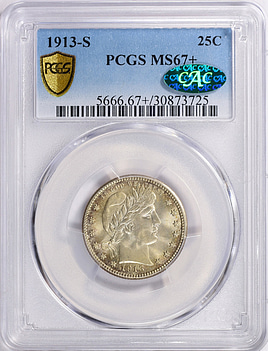
Auction Record: $172,000
Produced by: San Francisco Mint
Mintage: 40,000
Metal Content: 90% Silver, 10% Copper
Weight: 6.25 g (0.1808 oz)
The 1913-S Barber 25C coin refers to the second rarest group of real silver quarters for sale. What is unique is that this key-date variety is notoriously difficult to acquire, though some provident collectors have done their best to keep them intact for such a long time. Besides, according to numismatic resources, it is also one of the very few dates in the entire series known to exist in MS68 condition. Even heavily circulated examples remain valuable, so what if you hold one?…
1918/7-S Standing Liberty 25C
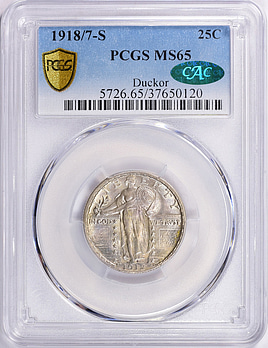
Auction Record: $162,500
Produced by: San Francisco Mint
Mintage: Part of the total 11,072,000 (exact number of overdates unknown)
Metal Content: 90% Silver, 10% Copper
Weight: 6.25 g (0.1808 oz)
The 1918/7-S Standing Liberty 25C is one of the most famous and valuable overdate varieties in American coinage ever known to exist. Numismatists claim that such an error was discovered in the late 1930s, when it was taken to auctions for the first time.
Even when in lower circulated grades, it may be sold for thousands of dollars. The key is that no known examples have achieved Gem MS65 status with Full Head (FH) designation, which gives us a hint that this silver quarters value might increase even more.
1926-D Standing Liberty 25C

Auction Record: $79,000
Produced by: Denver Mint
Mintage: 1,716,000
Metal Content: 90% Silver, 10% Copper
Weight: 6.25 g (0.1808 oz)
1926 seems like a remote past. However, some relics of those times are still present, especially in heavily circulated conditions. During that period, the Denver mint had relatively low quality control, making sharp strikes with full design elements particularly hard to find. Nonetheless, the 1926-D Standing Liberty 25C is a fine example of how high-graded coins may be considered expensive, even though its counterparts are relatively casual.
1932-D Washington 25C
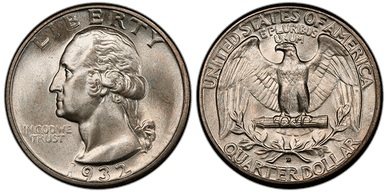
Auction Record: $143,750
Produced by: Denver Mint
Mintage: 436,800
Metal Content: 90% Silver, 10% Copper
Weight: 6.25 g (0.1808 oz)
The Washington series also has several rarities to observe. Of the rarest is the 1932-D Washington 25C with a mintage under one million coins (the other being the 1932-S). Examples in Gem condition are exceptionally rare, and this has helped drive values to impressive heights.
1949-D Washington 25C
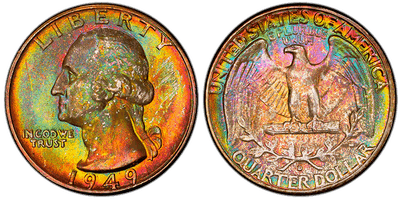
Auction Record: $43,475
Produced by: Denver Mint
Mintage: 10,068,400
Metal Content: 90% Silver, 10% Copper
Weight: 6.25 g (0.1808 oz)
The 1949-D Washington 25C may not be rare in terms of overall mintage (over 10 million coins have been struck!), but it is still considered scarcer than most other Washington quarters from the 1940s. Collectors are ready to pay a lot for items that meet certain criteria, i.e., high grades, full detail, and original luster.
1999-S Delaware 25C Silver Proof DCAM
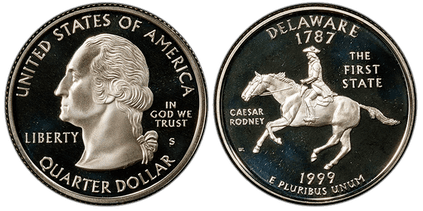
Auction Record: $17,250
Produced by: San Francisco Mint
Mintage: 804,565
Metal Content: 90% Silver, 10% Copper
Weight: 6.25 g (0.1808 oz)
As the first coin in the 50 State Quarters Program, this falls under the rule that first-timers are always the most valuable. Struck in 90% silver with Deep Cameo (DCAM) designation, it proudly features Caesar Rodney on horseback and the inscription “THE FIRST STATE”. Indeed, we cannot call these instances as rare as those mentioned at the top of the list. This 25-cent coin demonstrates that even modern creations can turn into valuable assets on the spot.
2021-S Tuskegee Airmen 25C Silver Proof First Strike DCAM

Auction Record: $490
Produced by: San Francisco Mint
Mintage: 490,829
Metal Content: 90% Silver, 10% Copper
Weight: 6.25 g (0.1808 oz)
Released within the America the Beautiful series, this instance commemorates the legendary African American fighter pilots of World War II. Unlike the previous sample, it was the final coin in the series, which turned out to be popular among collectors, thanks to its decent pricing and astonishing appearance.
2023-S Jovita Idar 25C Silver Proof DCAM
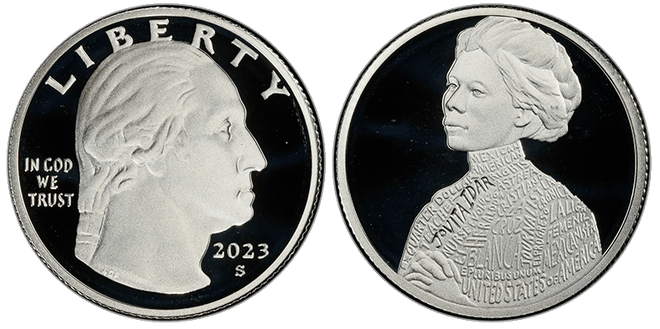
Auction Record: $350
Produced by: San Francisco Mint
Mintage: Not officially reported
Metal Content: 99.9% Silver
Weight: 6.25 g (0.2000 oz)
The US Mint took a major step toward commemorating those who are frequently neglected – women. Struck in 99.9% silver, the 2023-S Jovita Idar 25C pays tribute to the journalist and civil rights activist. Yes, it is not yet that rare, though it is the last year for silver quarters so far that can be worth a fortune in the end..
Investing in Rare Silver Quarters: Is It Worth It?
Without the right tools, it might be concerning to enter the numismatic hunt. While other collectors and investors are scratching their heads, trying to guess which coins are to become valuable over time, advanced numismatists choose Coin ID Scanner.
Without the right tools, it might be concerning to enter the numismatic hunt. While other collectors and investors are scratching their heads, trying to guess which coins are to become valuable over time, advanced numismatists choose Coin ID Scanner.
Coin ID Scanner is a fine tool that incorporates numerous features, e.g., coin identification by photo, error detection, extended encyclopedia with comprehensive information about each coin known to the numismatic world, collection management, and even more!
Identify. Learn. Store. This is all you need for your collection to expand.